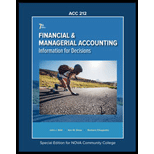
1.
To compute: Market value of share.
1.
Explanation of Solution
Formula for market value of share:
Given,
Total number of shares is 18,000.
Market price of share is $90.
Substitute, 18,000 for total number of shares and $90 for market price of share in the above formula,
Hence, the market value of common stock is $1,620,000.
2.
To compute: Par value of common stock and
2.
Explanation of Solution
Formula for par value of stock:
Common stock:
Given,
Common stock is $900,000.
Number of outstanding shares is 18,000.
Substitute, $900,000 for common stock and 18,000 for number of outstanding shares in the above formula,
Hence, the par value of common stock is $50.
Preferred stock:
Given,
Preferred stock is $375,000.
Number of outstanding shares is 1,500.
Substitute, $80,000 for preferred stock and 1,000 for number of outstanding shares in the above formula,
Hence, the par value of preferred stock is $250.
3.
To compute: Book value of common stock with no arrears.
3.
Explanation of Solution
Formula for book value of common stock:
Given,
Stockholder’s equity is $2,400,000.
Preferred stock is $375,000.
Number of common shares is 18,000.
Substitute, $2,400,000 for stockholder’s equity,$375,000 for preferred stock and 18,000 for number of common share in the above formula,
Hence, the market value of common stock is $112.50.
4.
To compute: Book value of common stock with arrears.
4.
Explanation of Solution
Formula for book value of common stock:
Given,
Stockholder’s equity is $2,340,000.
Preferred stock is $375,000.
Number of common shares is 18,000.
Substitute, $2,34,000 for stockholder’s equity,$375,000 for preferred stock and 18,000 for number of common share in the above formula,
Hence, the market value of common stock is $109.17.
Working Notes:
Calculation for stockholder’s equity:
5.
To compute: Dividend paid to preferred and common shareholders and dividend per share for common stock.
5.
Explanation of Solution
Preferred dividend
Formula for preferred dividend:
Given,
Preferred stock is $375,000.
Rate of interest is 8%.
Number of years is 3.
Substitute, $375,000 for preferred stock, 8% for rate of interest and 3 for number of years in the above formula,
Hence, the preferred dividend is $90,000.
Common stock dividend:
Formula for common stock dividend:
Given,
Preferred dividend is $90,000.
Total dividend is $100,000.
Substitute, $90,000 for preferred dividend and $100,000 for total dividend in the above formula,
Hence, the common stock dividend is $90,000.
Formula for dividend per share:
Given,
Total dividend is $10,000.
Number of outstanding shares is 18,000.
Substitute, $10,000 for total dividend and 18,000 for number of outstanding shares in the above formula,
Hence, the market value of common stock is $0.56.
6.
To explain: Reasons for the difference between market and book value of share.
6.
Explanation of Solution
Reasons for the difference between market and book value are:
- Assets and liabilities are recorded at historical cost and not on market value.
- Book value show the price of share according to the books of the company but market value is determined by the demand or supply of that particular stock.
Hence, the reason is demand and supply and historical concept followed for accounting.
Want to see more full solutions like this?
Chapter 11 Solutions
FIN & MANAGERIAL ACCT VOL 2 W/CONNECT
- Internal control refers to the processes and procedures implemented by an organization to ensure the integrity of financial and accounting information, promote accountability, and prevent fraud. These controls are designed to provide reasonable assurance that the organization achieves its objectives in operational efficiency, financial reporting reliability, and compliance with laws and regulations. Internal control is a comprehensive system that includes a variety of checks and balances, such as segregation of duties, authorization and approval processes, reconciliations, and physical security measures. It is an integral part of an organization's governance framework, helping to safeguard assets, improve operational efficiency, and ensure accurate and timely financial reporting. Respond to the above postarrow_forwardI need the correct answer to this general accounting problem using the standard accounting approach.arrow_forwardYou are a team of accounting consultants hired by the company VinGrenDom Ltd., a regional utility and manufacturing firm expanding into the Eastern Caribbean. The Board of Directors is requesting an accounting report that addresses three critical areas in their financial statements. Part A: Working Capital 1. Define working capital and explain its importance in financial health and liquidity management. 2. Assess how the matching concept and accrual basis affect the reporting of current assets and liabilities. 3. Using a hypothetical balance sheet (you may create one), identify at least 5 current assets and 5 current liabilities and analyze how changes in these elements affect liquidity ratios. 4. Recommend at least two strategies VinGrenDom Ltd. can implement to optimize working capital.arrow_forward

 AccountingAccountingISBN:9781337272094Author:WARREN, Carl S., Reeve, James M., Duchac, Jonathan E.Publisher:Cengage Learning,
AccountingAccountingISBN:9781337272094Author:WARREN, Carl S., Reeve, James M., Duchac, Jonathan E.Publisher:Cengage Learning, Accounting Information SystemsAccountingISBN:9781337619202Author:Hall, James A.Publisher:Cengage Learning,
Accounting Information SystemsAccountingISBN:9781337619202Author:Hall, James A.Publisher:Cengage Learning, Horngren's Cost Accounting: A Managerial Emphasis...AccountingISBN:9780134475585Author:Srikant M. Datar, Madhav V. RajanPublisher:PEARSON
Horngren's Cost Accounting: A Managerial Emphasis...AccountingISBN:9780134475585Author:Srikant M. Datar, Madhav V. RajanPublisher:PEARSON Intermediate AccountingAccountingISBN:9781259722660Author:J. David Spiceland, Mark W. Nelson, Wayne M ThomasPublisher:McGraw-Hill Education
Intermediate AccountingAccountingISBN:9781259722660Author:J. David Spiceland, Mark W. Nelson, Wayne M ThomasPublisher:McGraw-Hill Education Financial and Managerial AccountingAccountingISBN:9781259726705Author:John J Wild, Ken W. Shaw, Barbara Chiappetta Fundamental Accounting PrinciplesPublisher:McGraw-Hill Education
Financial and Managerial AccountingAccountingISBN:9781259726705Author:John J Wild, Ken W. Shaw, Barbara Chiappetta Fundamental Accounting PrinciplesPublisher:McGraw-Hill Education





